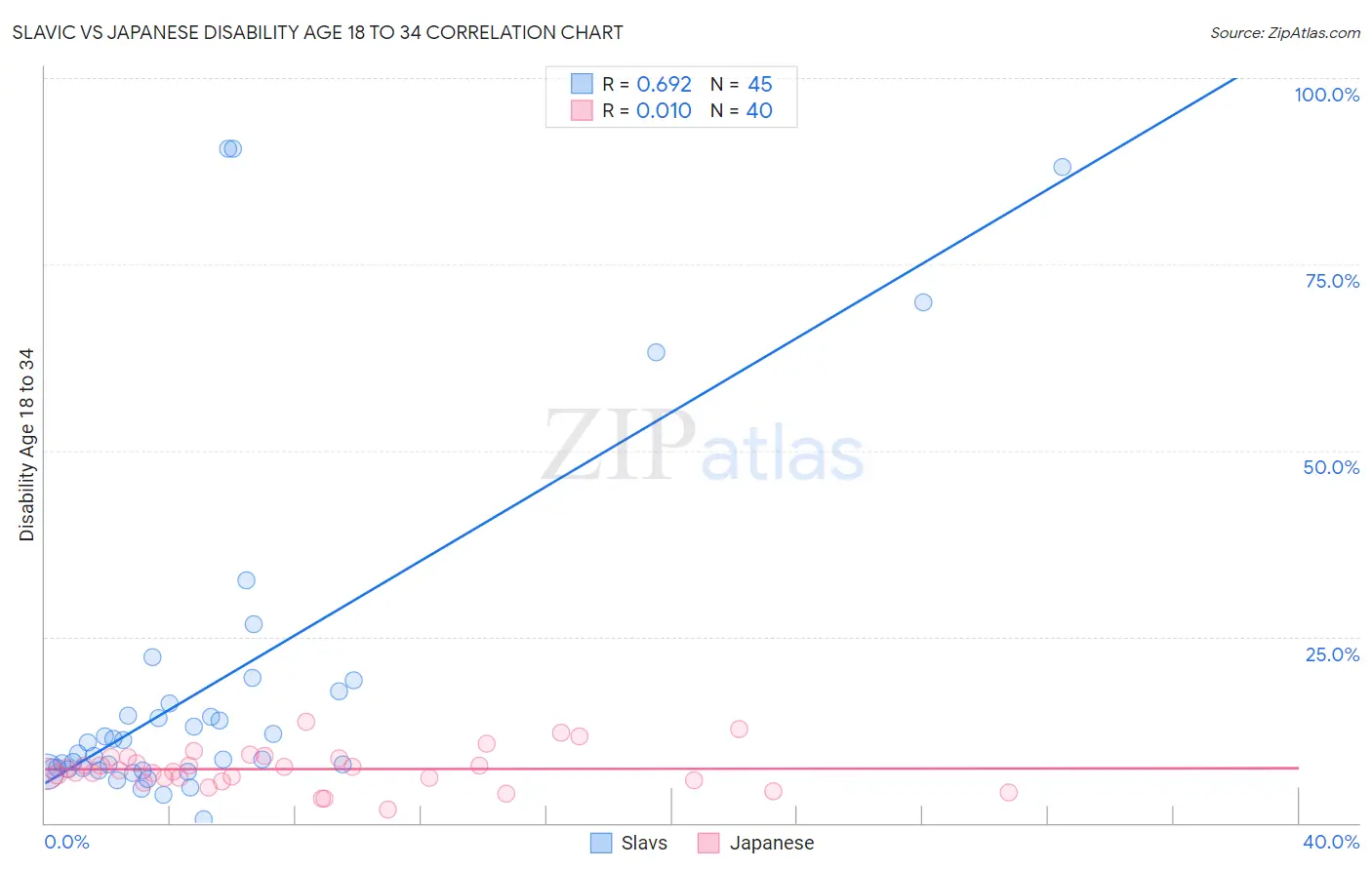Slavic vs Japanese Disability Age 18 to 34
COMPARE
Slavic
Japanese
Disability Age 18 to 34
Disability Age 18 to 34 Comparison
Slavs
Japanese
7.4%
DISABILITY AGE 18 TO 34
0.1/ 100
METRIC RATING
273rd/ 347
METRIC RANK
6.8%
DISABILITY AGE 18 TO 34
12.8/ 100
METRIC RATING
206th/ 347
METRIC RANK
Slavic vs Japanese Disability Age 18 to 34 Correlation Chart
The statistical analysis conducted on geographies consisting of 270,473,270 people shows a significant positive correlation between the proportion of Slavs and percentage of population with a disability between the ages 18 and 35 in the United States with a correlation coefficient (R) of 0.692 and weighted average of 7.4%. Similarly, the statistical analysis conducted on geographies consisting of 248,950,888 people shows no correlation between the proportion of Japanese and percentage of population with a disability between the ages 18 and 35 in the United States with a correlation coefficient (R) of 0.010 and weighted average of 6.8%, a difference of 8.4%.

Disability Age 18 to 34 Correlation Summary
| Measurement | Slavic | Japanese |
| Minimum | 0.47% | 1.8% |
| Maximum | 90.5% | 13.6% |
| Range | 90.0% | 11.8% |
| Mean | 18.6% | 7.2% |
| Median | 9.3% | 7.0% |
| Interquartile 25% (IQ1) | 7.2% | 5.9% |
| Interquartile 75% (IQ3) | 16.9% | 8.8% |
| Interquartile Range (IQR) | 9.7% | 2.9% |
| Standard Deviation (Sample) | 23.2% | 2.6% |
| Standard Deviation (Population) | 23.0% | 2.5% |
Similar Demographics by Disability Age 18 to 34
Demographics Similar to Slavs by Disability Age 18 to 34
In terms of disability age 18 to 34, the demographic groups most similar to Slavs are African (7.4%, a difference of 0.010%), Tsimshian (7.4%, a difference of 0.050%), Immigrants from Somalia (7.4%, a difference of 0.080%), European (7.4%, a difference of 0.13%), and Swiss (7.4%, a difference of 0.14%).
| Demographics | Rating | Rank | Disability Age 18 to 34 |
| German Russians | 0.1 /100 | #266 | Tragic 7.4% |
| Bangladeshis | 0.1 /100 | #267 | Tragic 7.4% |
| Portuguese | 0.1 /100 | #268 | Tragic 7.4% |
| Basques | 0.1 /100 | #269 | Tragic 7.4% |
| Belgians | 0.1 /100 | #270 | Tragic 7.4% |
| Swiss | 0.1 /100 | #271 | Tragic 7.4% |
| Tsimshian | 0.1 /100 | #272 | Tragic 7.4% |
| Slavs | 0.1 /100 | #273 | Tragic 7.4% |
| Africans | 0.1 /100 | #274 | Tragic 7.4% |
| Immigrants | Somalia | 0.1 /100 | #275 | Tragic 7.4% |
| Europeans | 0.1 /100 | #276 | Tragic 7.4% |
| Immigrants | Portugal | 0.1 /100 | #277 | Tragic 7.4% |
| Lumbee | 0.1 /100 | #278 | Tragic 7.4% |
| Czechoslovakians | 0.1 /100 | #279 | Tragic 7.4% |
| Yaqui | 0.1 /100 | #280 | Tragic 7.4% |
Demographics Similar to Japanese by Disability Age 18 to 34
In terms of disability age 18 to 34, the demographic groups most similar to Japanese are Mexican (6.8%, a difference of 0.030%), Immigrants from Scotland (6.8%, a difference of 0.050%), Lebanese (6.8%, a difference of 0.080%), Immigrants from Burma/Myanmar (6.8%, a difference of 0.080%), and Immigrants from Bosnia and Herzegovina (6.8%, a difference of 0.13%).
| Demographics | Rating | Rank | Disability Age 18 to 34 |
| Kenyans | 18.3 /100 | #199 | Poor 6.8% |
| Sierra Leoneans | 17.5 /100 | #200 | Poor 6.8% |
| Greeks | 16.1 /100 | #201 | Poor 6.8% |
| Panamanians | 15.8 /100 | #202 | Poor 6.8% |
| Hispanics or Latinos | 13.8 /100 | #203 | Poor 6.8% |
| Immigrants | Bosnia and Herzegovina | 13.6 /100 | #204 | Poor 6.8% |
| Lebanese | 13.3 /100 | #205 | Poor 6.8% |
| Japanese | 12.8 /100 | #206 | Poor 6.8% |
| Mexicans | 12.6 /100 | #207 | Poor 6.8% |
| Immigrants | Scotland | 12.4 /100 | #208 | Poor 6.8% |
| Immigrants | Burma/Myanmar | 12.3 /100 | #209 | Poor 6.8% |
| Latvians | 11.1 /100 | #210 | Poor 6.8% |
| Immigrants | Norway | 10.0 /100 | #211 | Tragic 6.8% |
| Luxembourgers | 9.4 /100 | #212 | Tragic 6.9% |
| Immigrants | Western Europe | 9.1 /100 | #213 | Tragic 6.9% |